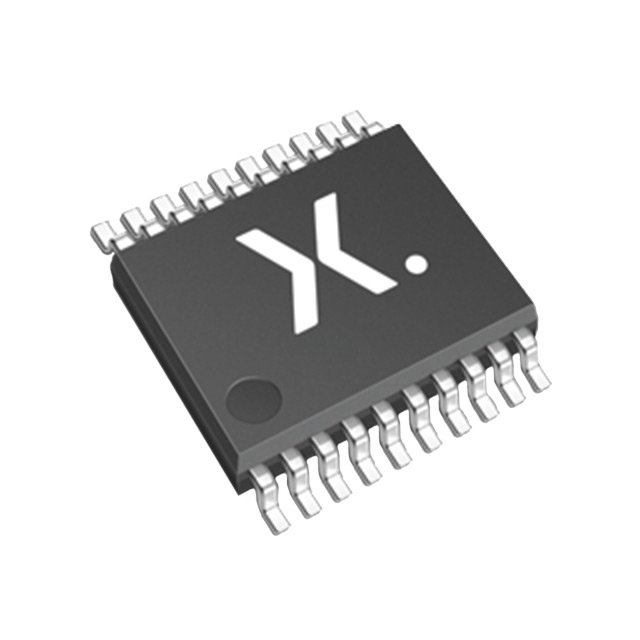Xem thông số kỹ thuật để biết chi tiết sản phẩm.

74LV245PW,118
Basic Information Overview
- Category: Integrated Circuit (IC)
- Use: Level Shifter/Transceiver
- Characteristics: Bidirectional, Non-Inverting, 8-bit, 3-state
- Package: TSSOP (Thin Shrink Small Outline Package)
- Essence: Logic Level Conversion and Signal Transmission
- Packaging/Quantity: Tape and Reel, 2500 pieces per reel
Specifications
- Supply Voltage Range: 1.65V to 5.5V
- High-Level Input Voltage: 2V to VCC + 0.5V
- Low-Level Input Voltage: -0.5V to 0.8V
- High-Level Output Voltage: VCC - 0.5V
- Low-Level Output Voltage: 0.5V
- Maximum Operating Frequency: 125 MHz
- Number of Channels: 8
Detailed Pin Configuration
The 74LV245PW,118 IC has a total of 20 pins arranged in a TSSOP package. The pin configuration is as follows:
__ __
A1 -| 1 20 |- VCC
B1 -| 2 19 |- OE#
A2 -| 3 18 |- I/O1B
B2 -| 4 17 |- I/O2B
A3 -| 5 16 |- I/O3B
B3 -| 6 15 |- I/O4B
A4 -| 7 14 |- I/O5B
B4 -| 8 13 |- I/O6B
GND-| 9 12 |- I/O7B
DIR-|10 11 |- I/O8B
¯¯ ¯¯
Functional Features
- Bidirectional Data Transfer: The 74LV245PW,118 allows data to be transferred bidirectionally between two buses.
- Non-Inverting Logic: The IC does not invert the logic levels of the input signals during transmission.
- 3-state Outputs: The outputs can be put into a high-impedance state, allowing multiple devices to share a common bus without interference.
Advantages and Disadvantages
Advantages: - Wide Supply Voltage Range: Can operate with a wide range of supply voltages, making it versatile for various applications. - High-Speed Operation: Supports a maximum operating frequency of 125 MHz, enabling fast data transfer. - Small Package Size: The TSSOP package offers a compact form factor, suitable for space-constrained designs.
Disadvantages: - Limited Channel Count: The IC provides 8 channels, which may not be sufficient for applications requiring a higher number of data lines. - Lack of ESD Protection: The IC does not have built-in Electrostatic Discharge (ESD) protection, requiring additional external measures for ESD protection.
Working Principles
The 74LV245PW,118 is designed as an octal bus transceiver with 3-state outputs. It facilitates the bidirectional transfer of data between two buses operating at different voltage levels. The DIR pin controls the direction of data flow, while the OE# pin enables or disables the outputs. When the OE# pin is active, the outputs are in a high-impedance state, allowing other devices to drive the bus. The IC uses non-inverting logic, ensuring that the input signal's logic level is maintained during transmission.
Detailed Application Field Plans
The 74LV245PW,118 is commonly used in various applications that require level shifting and signal transmission between different voltage domains. Some of the typical application fields include: - Microcontroller interfacing - Data communication systems - Industrial automation - Automotive electronics - Consumer electronics
Detailed and Complete Alternative Models
- SN74LV245APWR: Similar octal bus transceiver IC from Texas Instruments, available in a TSSOP package.
- MC74LVX245DTR2G: Octal non-inverting bus transceiver IC from ON Semiconductor, offered in a TSSOP package.
- CD74HCT245E: Octal bus transceiver with 3-state outputs from Texas Instruments, packaged in a DIP format.
These alternative models provide similar functionality to the 74LV245PW,118 and can be considered as substitutes based on specific requirements.
Word count: 409 words
Liệt kê 10 câu hỏi và câu trả lời thường gặp liên quan đến ứng dụng 74LV245PW,118 trong giải pháp kỹ thuật
Sure! Here are 10 common questions and answers related to the application of 74LV245PW,118 in technical solutions:
Q: What is the 74LV245PW,118? A: The 74LV245PW,118 is a octal bus transceiver with 3-state outputs, commonly used for bidirectional data transfer between different voltage levels.
Q: What is the operating voltage range of the 74LV245PW,118? A: The 74LV245PW,118 operates within a voltage range of 1.65V to 5.5V.
Q: How many channels does the 74LV245PW,118 have? A: The 74LV245PW,118 has 8 channels, allowing bidirectional data transfer on each channel.
Q: Can the 74LV245PW,118 handle high-speed data transfer? A: Yes, the 74LV245PW,118 is designed to support high-speed data transfer up to 400 Mbps.
Q: What is the maximum output current of the 74LV245PW,118? A: The 74LV245PW,118 can provide a maximum output current of 24 mA per channel.
Q: Is the 74LV245PW,118 compatible with both TTL and CMOS logic levels? A: Yes, the 74LV245PW,118 is compatible with both TTL and CMOS logic levels, making it versatile for various applications.
Q: Can the 74LV245PW,118 be used as a level shifter? A: Yes, the 74LV245PW,118 can be used as a level shifter to convert signals between different voltage levels.
Q: Does the 74LV245PW,118 have built-in protection features? A: Yes, the 74LV245PW,118 has built-in ESD protection to safeguard against electrostatic discharge.
Q: Can the 74LV245PW,118 be used in automotive applications? A: Yes, the 74LV245PW,118 is qualified for automotive applications and can operate within the specified temperature range.
Q: What package does the 74LV245PW,118 come in? A: The 74LV245PW,118 is available in a TSSOP-20 package, which is compact and suitable for space-constrained designs.
Please note that these answers are general and may vary depending on the specific datasheet and manufacturer's specifications of the 74LV245PW,118.

